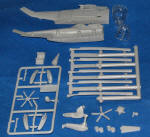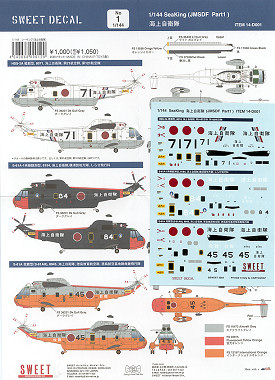In December 1957, the US Navy gave the go-ahead to a new programme for a very high performance helicopter with advanced technology, to replace the outdated S-58 (HSS-1). Sikorsky was approached again and submitted a project for a big twin turbine aircraft with a boat-type hull and retractable landing gear for amphibious operations. The aircraft had all-weather capability, a good choice of weapons loads and four hours' endurance. The project was designated S-61 and the HSS-2 prototype flew on 11 March 1959. The prototype was followed by seven pre-production aircraft (YHSS-2) which successfully completed service trials in 1960. The US Navy ordered the first ten S-61B/HSS-2 for delivery starting in September 1961. The helicopters were later redesignated SH-3A Sea King. One of the first production models set up a world speed record of 339 km/h on 5 February 1962.
The main rotor of the medium-tonnage S-61 was of the articulated type, with five interchangeable blades which could be folded automatically by hydraulic actuators. The tail boom could also be folded for stowage on board ship. The all-metal, semi-monocoque boat-type hull was amphibious, the twin main wheels retracting into two sponsons. In the SH-3A version 255 were produced, while ten more, ordered as HSS-2Z and subsequently redesignated VH-3A, were assigned to the special American Presidential Department for personnel transport and evacuation services in case of emergency. Nine of the SH-3As were transformed into RH-3As with minesweeping equipment and three were used by the USAF for missile site support and drone recovery. Another 12 SH-3As were converted into the HH-3A for battlefield rescue work, and were fitted with two Emerson TAT-102 turrets mounted at the rear of the two sponsons, and an in-flight refueling probe.
In April 1962, the USAF leased three HSS-2, transformed into 27-seat transport aircraft for services linking the Texas Towers radar installations. Another three S-61As were purchased for this purpose. Sixteen S-61A-4s with 31 seats were acquired by the Royal Malaysian Air Force and nine by the Danish Air Force for rescue work. In response to a Japanese naval specification, Mitsubishi obtained a license to produce the S-61; three were purchased directly from Sikorsky and by February 1972, 43 locally-produced aircraft had been delivered.
From 1966, the SH-3A was superseded by the SH-3D, which had a 1419shp T58-GE-10 turbine and new electronics. The first SH-3D delivered in June 1966 was one of six ordered by the Spanish Navy. This was followed by another four for the Brazilian Navy and 73 for the US Navy. The new variant was also built under license by Agusta from 1967, following an Italian naval order for an ASW helicopter to replace the old Sikorsky SH-34. An initial batch of 24 was built for the Italian Navy and 20 for the Iranian Navy (three in the VIP version); the Italian SH-3D is identical to the American model, apart from the installation of a Teledyne Doppler radar and a search radar on the left side of the nose.
The SH-3D in USN service was upgraded to the SH-3H variant. A non-ASW version, the SH-3G was also produced. These two types included a more powerful engine system which required a larger horizontal stabilizer with a support rod. This was retrofitted to some SH-3Ds. The last USN versions were UH-3H's where all the ASW equipment was removed, making them quite similar to the SH-3G.
In Britain, the Royal Navy also chose the S-61 to replace its old Wessex. Westland acquired the license to build the SH-3 in 1959, and the British specification called for some modifications. Thus a pair of 1521shp Rolls-Royce Gnome H-1400 turbines were adopted, plus other British equipment including an Ekco all-weather radar (easily recognized by the dorsal radome), Plessey dipping sonar, Marconi Doppler navigation radar, etc.
The first British-built Sea King flew on 7 May 1969 and the first squadrons were formed the following August. The Westland version has completely different engines and avionics from the US versions. Westland has built over 200 Sea Kings, including the Sea King Mk.1, 2 and 5 for the Royal Navy, 15 for the Indian Navy (Sea King Mk.42), 22 for the German Navy (Mk.41), 11 for the Norwegian Air Force (Mk.43) and 12 for the Australian Navy (Mk.50). Westland also designed and built a tactical helicopter called Commando, which is directly derived from the Sea King, and the first examples flew in 1973. Commandos have been supplied to Egypt and Qatar and, as the Sea King HC Mk.4, to the Royal Navy.
Though now nearly gone from the USN inventory and long gone from USAF units, the Sea King is still a very important type with many military air arms throughout the world.
Instructions don't exist. I guess that Sweet figures these are easy enough, so why pay for instructions. What you do get is an excellent decal sheet. It contains full markings for three aircraft, all Japanese Navy Sea Kings with five blade tail rotors, no spray guards and with the shorter horizontal stab. Three very different schemes as well with one in the 'standard' white over light gull grey, one in engine grey with 'fluorescent yellow' bits, and the third in ADC Grey over International Orange with 'fluorescent yellow' sections. In all some very colorful schemes. I find it a bit odd that there would be complete markings for all three when one can only do one from the kit, but the decals are superbly printed and quite colorful. The sheet includes window markings in black and frankly, when I do mine, I'll be painting the cockpit transparencies in black as well.
 Sweet has an excellent reputation for producing quality 1/144 scale kits, providing fidelity to the original and detail levels that were rarely seen in these small scale kits. To my knowledge, this is the first helicopter kit they have produced and the first snap-tite. Despite what many people may think of as a rather toy-like way of producing a kit, the truth is that these are very nicely done and most of us will be gluing these together.
Sweet has an excellent reputation for producing quality 1/144 scale kits, providing fidelity to the original and detail levels that were rarely seen in these small scale kits. To my knowledge, this is the first helicopter kit they have produced and the first snap-tite. Despite what many people may think of as a rather toy-like way of producing a kit, the truth is that these are very nicely done and most of us will be gluing these together. 
